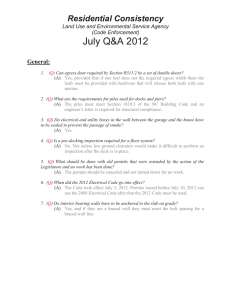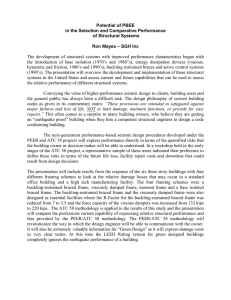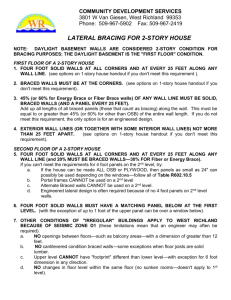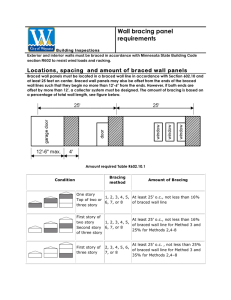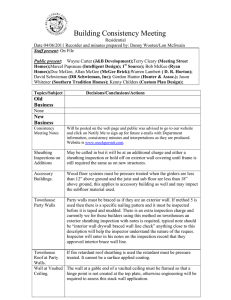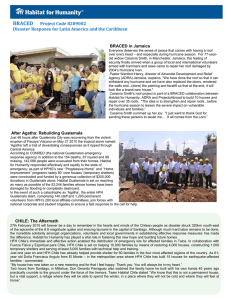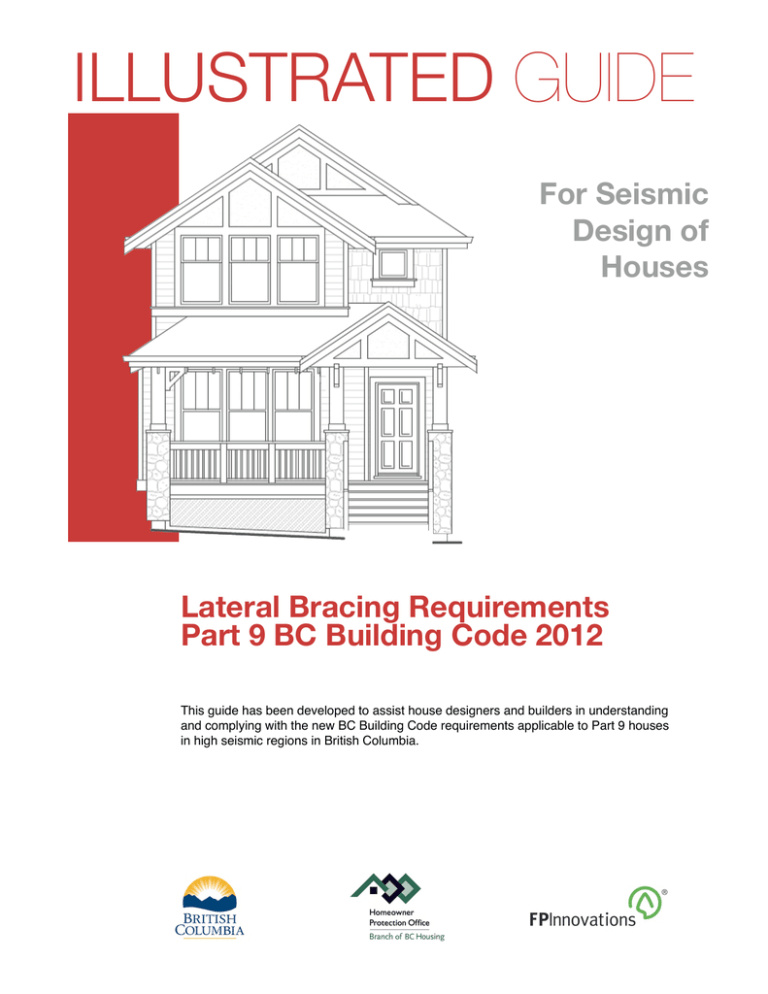
ILLUSTRATED GUIDE
For Seismic
Design of
Houses
Lateral Bracing Requirements
Part 9 BC Building Code 2012
This guide has been developed to assist house designers and builders in understanding
and complying with the new BC Building Code requirements applicable to Part 9 houses
in high seismic regions in British Columbia.
Organization of this Guide
Introduction ………………………………………………………….." 3
Section 1 - Main Requirements ……………………………………." 5
Section 2 - Exceptions ………………………………………………"15"
Section 3 - Trade Offs ………………………………………………."17
Section 4 - Construction Requirements …………………………..."20
Appendix …………………………………………………………….."22
Acknowledgements
The Homeowner Protection Office (HPO) is indebted to members of the steering and industry
committees for their guidance, expertise and thorough review of this publication. Special
recognition is acknowledged for the significant contributions of the Building and Safety Standards
Branch, FPInnovations, Kwantlen Polytechnic University, Building Officialsʼ Association of BC,
Canadian Home Buildersʼ Association of BC, Morningstar Homes, City of Vancouver, City of
Burnaby, Applied Science Technologists and Technicians of BC, and in particular, Terry Beck,
Richard Bushey, Bob Deeks, Linden Holmen, Denisa Ionescu, Steven Kuan, Matthew Lam, Eric
Lee, Chun Ni, Ron Rapp, Patrick Shek and Bob Thompson. This guide was prepared by
Constructive Home Solutions Inc. Special thanks are extended to Murray Frank for the industry
expertise, insight and dedication to this project.
Disclaimer
This illustrated guide is only intended to provide readers with general information about aspects
of Part 9 of the British Columbia Building Code (the “Code”). Readers are urged not to rely simply
on this guide but to carefully review the Code and consult with appropriate and reputable
professionals and construction specialists to assist in interpreting and applying the Code. It is the
responsibility of all persons undertaking the design and construction of a home to fully comply
with the requirements of the Code. The authors, contributors, funders and publishers assume no
liability for the accuracy of the statements made or for any damage, loss, injury or expense that
may be incurred or suffered as a result of the use of or reliance on the contents of this guide. The
views expressed do not necessarily represent those of individual contributors or the Homeowner
Protection Office, a branch of BC Housing.
References
2
This guide contains most requirements for locating required lateral braced wall panels and the
construction details for those panels and is based on Part 9 of the BC Building Code. Version 1.0
Copyright © 2012 all rights reserved. No portion of this guide may be reproduced, stored in a
retrieval system or transmitted in any form, or by any means mechanical, electronic,
photocopying, recording or otherwise without the prior written permission of the
Homeowner Protection Office, a branch of BC Housing. Portions of the building code have been
reproduced from the 2010 National Building Code of Canada / BC Building Code with the
permission of the National Research Council of Canada and the Queenʼs Printer of British
Columbia, copyright holders.
Lateral Bracing - A Step-By-Step Process
Part 9 construction embraces the design and
construction of houses with prescriptive
requirements that result in safe, comfortable
houses. The building code is constantly
revised in response to the continually improving
understanding about the complex
environmental loads that impact the
performance of houses.
This guide has been produced in an effort to
clearly describe the new building code
requirements for lateral bracing of small woodframe structures in the high seismic regions of
British Columbia. Designers will need to
consider these requirements when creating the
form of the exterior walls, as well as
the dimensions and locations of
interior walls. Builders will need to
The Braced
understand the material
Wall Panel
requirements, as well as the
construction methods necessary to
The lateral forces
fabricate braced wall panels at
on a building
required locations throughout the
cannot be resisted
structure.
with unbraced
studs and plates.
The simple basis of improving the
The motion will
seismic response of a house to an
tend to deflect the
earthquake is to ensure that there is
studs and result in
adequate full height walls sheathed
significant damage
or finished with panels well fastened
or even failure.
to the frame. The basic, sheathed
By adding
sheathing (such as
plywood or OSB) to
the exterior, and
drywall or panelling
to the interior, the
resistance to lateral
loads can be
achieved.
“The basic, sheathed wall is very strong
at resisting the typical lateral movement
(back and forth) of the ground
experienced during an earthquake”
INTRODUCTION
Introduction
Several of these braced wall panels installed at
key locations from the foundation to the roof
structure, and located on all exterior walls of
the house, result in a very strong structure.
Interruptions in the braced wall panels from
openings (such as windows) or significant
misalignment (such as walls on subsequent
floors that are significantly set back from lower
floors), result in a reduction of structural
capacity to resist lateral loads.
The new lateral bracing requirements for high
seismic regions are determined by following a
step-by-step process. The first step is to
confirm that the entire perimeter from
foundation to roof is enclosed by imaginary
braced wall bands, and to identify if additional
imaginary braced wall bands are needed at
intermediate points within the house. The next
step is to locate a minimum number of braced
wall panels at key locations within these bands,
and then to construct the braced wall panels.
wall is very strong at resisting the
typical lateral movement (back and
forth) of the ground experienced
during an earthquake.
Braced wall panels
are portions of
walls where
exterior sheathing
or interior finish is
designed and
installed to provide
the required
resistance to lateral
loads due to
earthquakes.
3
INTRODUCTION
Seismic Regions
Seismic Regions
Seismic hazards at a site can be characterized
by the spectral acceleration at 0.2 seconds,
identified as Sa(0.2). There are 40 locations in
B.C. identified as high seismic locations ( Sa(0.2)
> 0.7 ) in Table C-2 of the Appendix to the B.C.
Building Code, and all are located in the
southwest corner of the Province. The criteria
for high wind does not apply to any community
found in Table C-2.
Seismic Categories (BC)
Low Seismic Region
Standard Provisions Not Required
Sa(0.2) ≤ 0.70
High Seismic Region
Standard Provisions
0.70 < Sa(0.2) < 1.0
Standard Provisions, Closer Braced
Wall Band Spacing
1.0 ≤ Sa(0.2) ≤ 1.1
Standard Provisions, Closer Braced Wall
Band Spacing, No Heavy Construction
1.1 < Sa(0.2) ≤ 1.2
In an earthquake, the acceleration of the ground creates
lateral forces on a structure. The magnitude of the lateral
forces on a house is influenced by its height and weight.
The exterior and interior walls are the key components
for resisting the lateral forces collected from the floors
and roof over the height of the house.
Part 9 houses can be quite resistant to lateral loads
because of the redundant nature of wood-frame
construction. House designs can also include features
that result in a reduction of the resistance to lateral
seismic loading, such as large openings through exterior
walls; open interior floor plans (which eliminate many of
the interior walls); and the use of heavy construction
4
Lower Mainland
Greater Victoria
methods like concrete floor toppings and/or tile roofing.
Failure can occur in shear at the roof-to-wall, wall-to-wall,
and wall-to-foundation connections, as well as racking
failure of the walls.
This illustrated guide provides guidelines for building
houses in regions where the spectral acceleration,
Sa(0.2) is greater than 0.7, and less than or equal to 1.2
(1.1 for a particular case of heavy construction). The
guidelines are also for regions where the 1-in-50 hourly
wind pressure is greater than 0.80 kPa but less than 1.2
kPa; however, no location in BC has design wind
pressure high enough to be in this range.
The Braced Wall Band
Up
The braced wall band is an imaginary continuous
straight band extending vertically and horizontally
through a building (or part of a building) in which
braced wall panels are constructed.
The first figure (top right) shows the three floor
plans aligned on a drawing and the up to 1.2 m
wide braced wall band shown enclosing all of the
walls of the front elevation of the house.
Ma
en
Ba
i
loo
nF
p
o
Flo
er
r
r
t
m
se
SECTION 1 - MAIN REQUIREMENTS
Main Requirements
The second figure (middle right) shows the band
applied to the floor plans as they would stack in
construction. Note that the walls on the front
elevation are located within the 1.2 m wide band.
The third figure (bottom right) shows the band
applied to the second elevation. Bands need to
be identified on the remaining elevations and any
required interior regions.
Step 1
Braced Wall Band
The braced wall band is an imaginary continuous
straight band extending vertically and horizontally
through a building (or part of a building) in which braced
wall panels are constructed. The first step is to ensure
that each perimeter wall and certain interior walls align
within an imaginary braced wall band, which extends
from the foundation to the roof. These walls must be
located within the up to 1.2 m wide braced wall band
from the foundation to the roof. i
i
9.23.13.4.(1)(a), (b) and (e), 9.23.13.4.(2) (see Appendix)
Braced wall bands must be located around the
perimeter of the building, and additional
braced wall bands may be required at interior
wall locations.
5
SECTION 1 - MAIN REQUIREMENTS
Braced Wall Bands
Example Building Sections
Braced wall bands can be up to 1.2 m wide. They must be full storey height and be aligned with
braced wall bands on the storeys above and below. The maximum space between bands
depends on whether they are in the basement or crawl space (where it can be up to 15 m) ii or
above (where it can be 10.6 m or 7.6 m depending on the specific Sa(0.2)). iii Exceptions and
trade offs are examined in Sections 2 and 3 of this guide.
Max 10.6 m (7.6 m)
Max 10.6 m (7.6 m)
Braced
Wall Band
The braced
wall band
must lap with
adjacent
braced wall
bands at both
ends. The
centre line of
each braced
wall band
extends to the
outer edge of
the connected
braced wall
bands.
Max 1.2 m
ii
9.23.13.5.(2)(a), (b) and (c);
iii
Max 1.2 m
Not Greater than 15 m Between Basement Walls
Designer Note
Plan View
Length
6
Max 1.2 m
Table 9.23.13.5. (see Appendix)
The length of the braced wall band is
measured on the centre line from
where it meets with the outside edge
of adjacent bands.
The end of a braced wall band is set at
the outside edge of adjacent bands.
A braced wall panel is a portion of a woodframe wall designed and installed to provide
the required resistance to lateral loads due
to earthquakes.
SECTION 1 - MAIN REQUIREMENTS
Braced Wall Panels
Braced wall
panels shown
with hatching
Step 2
Braced Wall Panels
A braced wall panel is a portion of a wood-frame wall
designed and installed to provide the required resistance
to lateral loads due to earthquakes. Unlike the imaginary
braced wall band, a braced wall panel is an actual
physical element that meets certain dimension and
construction requirements. Braced wall panels must be
located within a braced wall band to be considered
effective.iv
may also be used.v For interior braced wall panel walls,
both sides shall be finished with gypsum or wood based
products.vi They can be sheathed on one side only
provided that the wood-based panels are used and the
maximum spacing of the panel fasteners is reduced by
half.vii For braced wall panels in braced wall bands
required at 15 m intervals, only plywood, OSB or
diagonal lumber sheathing shall be used to construct the
braced wall panels.viii
Braced wall panel materials for exterior walls include
plywood, oriented strand board (OSB) or diagonal lumber
sheathing on one side of the wall. Panel-type cladding
iv
9.23.13.5.(1)(a);
v
9.23.13.6.(1)(a), (b) and (c);
vi
9.23.13.6.(2);
vii
9.23.13.6.(3);
viii
9.23.13.6.(6) (see Appendix)
7
SECTION 1 - MAIN REQUIREMENTS
Spacing and Dimensions
Offset
Wall
Profiles
The widths of
braced wall
bands
identified by
the designer
can have an
impact on the
design of the
house and the
layout of its
walls.
Designer Note
Plan View of Wall
The perimeter of building, and
certain interior walls, shall be
located within braced wall bands.
For simple straight walls, the band
need only be the width of the wall.
Wall
Braced Wall Band
Centre Line
Plan View of Wall
Walls that contain small offsets can be included within the braced wall
band as long as the band does not exceed 1.2 m in width and all of the
wall elements are located within the band. The jog in this wall is not
included as part of the length of the braced wall panel (even if it is
sheathed in accordance with the requirements for a braced wall panel).
Plan View of Wall
Walls that contain significant offsets will require separate braced wall
bands. Each band shall contain the required minimum braced wall
panels.
8
A
B
A
B
Plan View
B
B
Braced Wall Panel
SECTION 1 - MAIN REQUIREMENTS
Spacing and Dimensions
B
Braced Wall Band
Centre Line
C
C
C
B
A
B
Distance between centre lines of braced wall bands
C
Distance from end of braced wall band to end of first braced wall panel
Distance between braced wall panel edges
0.70 < Sa(0.2) < 1.0
1.0 ≤ Sa(0.2) ≤ 1.2
A Maximum
10.6 m
7.6 m
B Maximum
6.4 m
6.4 m
C Maximum
2.4 m
2.4 m
From Table 9.23.13.5. (see Appendix)
9
SECTION 1 - MAIN REQUIREMENTS
Spacing and Dimensions
Interior Braced
Wall Panels
25%
Exterior Braced
Wall Panels
25%
40%
75%
Light Construction - Minimum Length of Braced Wall Panels. ix
Concrete Tile Roof
Heavy
Construction
Heavy
construction is
any house that
includes either
concrete roof
tiles, concrete
floor topping,
or both.
25%
Concrete
Floor Topping
40%
75%
Heavy Construction - Minimum Length of Braced Wall Panels. ix
10
ix
Table 9.23.13.5. (see Appendix)
SECTION 1 - MAIN REQUIREMENTS
Spacing and Dimensions
Minimum length of braced wall panels when connecting to intersecting braced wall panels,
and minimum panel length in the field of the wall. x
Not More Than 15 m
Braced wall panels do not need to be continuous through the basement where the span
between basement walls does not exceed 15 m.
x
Table 9.23.13.5. (see Appendix)
11
SECTION 1 - MAIN REQUIREMENTS
Spacing and Dimensions
Wood
Sheathed
Braced
Wall
Panel
A wood
sheathed
braced wall
panel is a
braced wall
panel that
uses plywood,
OSB,
waferboard or
diagonal
lumber
sheathing on
both sides of
the wall.
Example for
house where
Sa(0.2) < 1.0
Can be omitted as the braced wall panel above is
not a wood sheathed braced wall panel, and the
span between basement walls is less than 15 m. xiii
A wood
sheathed
braced wall
panel can be
sheathed on
one side only
provided that
the sheathing
material is
plywood, OSB
or waferboard,
and the
maximum
spacing of
fasteners
along the edge
is half of the
maximum
allowable. xi
Cannot be omitted as the
basement wall span would
exceed 15 m.
Greater Than 15 m
If a wood sheathed braced wall panel is constructed on any floor (including the basement),
then wood sheathed braced wall panels are required throughout that braced wall band. xii
12
xi
9.23.13.6.(3);
xii
9.23.13.6.(4);
xiii
9.23.13.6.(6) (see Appendix)
Split Level
A split-level
house would
require a
braced wall
band at the
location of the
split when the
change in the
floor level is
greater than
the depth
of one floor
joist. xiv
xiv
9.23.13.4.(3) (see Appendix)
SECTION 1 - MAIN REQUIREMENTS
Spacing and Dimensions
13
SECTION 1 - MAIN REQUIREMENTS
Design Requirements
This flow chart is a
useful checklist for
confirming layout
requirements and
minimum panel areas
when designing for
seismic lateral loads.
Sa(0.2) ≥ 0.7
Yes
Sa(0.2) > 1.2
Yes
No
Standard
Part 9
Structural
Provisions
Sa(0.2) > 1.1
Yes
Yes
Heavy
Construction
No
Using this
Flow
Chart
Identify the
Sa(0.2) for the
community
from Table C-2
in the
Appendix to
the BC
Building Code.
Begin from the
top of the flow
chart and
establish
which
requirements
apply.
No
Heavy
Construction
Lateral Load
Qualifier
Sa(0.2) < 1.0
Yes
Yes
7.6 m Max
Between
Adjacent
Bands
6.4 m Max
Between
Adjacent
Panel Edges
> 1 Floor
Yes
on Lower Frame
Wall
10.6 m Max
Between
Adjacent
Bands
2.4 m Max
From Panel
Edge to End
of Band
Heavy
Construction
Supporting
Floors
600 mm Max
Panel Length
(Connected at
Corners)
Yes
Number of
Supported
Floors
2 Floors
No
3 Floors
Supporting
Floors
Minimum Panel
Length
> 2 Floors Yes
on Lower Frame
Wall
No
No
Layout
Requirements
No
1 Floor
14
Professional
Structural
Design
Required
No
Yes
Number of
Supported
Floors
1 Floor
750 mm Max
Panel Length
(Other Than
Corners)
Min total
Panel 40%
Length of
Band
Min total
Panel 75%
Length of
Band
2 Floors
Min total
Panel 25%
Length of
Band
There are some elements where the requirements for braced wall bands and braced
wall panels are not required.
Porches
The three
walls of any
porch
extending not
more than
3.5 m from the
building, and
supporting no
floors of
construction
above are
exempted
from bracing
requirements.
The extension
of the porch
from the
house shall
not exceed
half of the
length of the
porch. xv
SECTION 2 - EXCEPTIONS
Exceptions
The roof of the porch must be integral with the roof of the house, or framed and fastened
to the wall framing.
Detached
Garages
All detached
garages
supporting no
floors of
construction
are exempted
from bracing
xvi
requirements.
xv
9.23.13.5.(3)(a), (b), and (c);
xvi
9.23.13.5.(4) (see Appendix)
15
SECTION 2 - EXCEPTIONS
Exceptions
Attached
Garages
The front wall
of attached
garages
serving a
single dwelling
unit and
supporting no
floors of
construction is
exempt from
bracing
requirements. xvii
Attached
Garages
If the attached
garage
supports not
more than one
floor of
construction,
the garage
door is a
permitted
large opening,
provided that
there is
adequate
bracing of the
other three
walls of the
garage and
that the back
wall of the
garage is not
more than 7.6
m from the
xviii
garage door.
16
xvii
9.23.13.5.(4);
xviii
9.23.13.5.(5)(a), (b), (c), and (d) (see Appendix)
Not More Than 7.6 m
The following trade offs have been developed to address the need for greater design flexibility
when applying the lateral load provisions to Part 9 structures.
1. Open Concept
Wood
Sheathed
Braced
Wall
Panel
The 7.6 m
separation
between
braced wall
bands in
locations
where Sa(0.2)
is from 1.0 to
1.2, can be
increased to a
maximum of
10.6 m,
provided that
the interior
braced wall
band contains
wood
sheathed
braced wall
panels. xix
SECTION 3 - TRADE OFFS
Trade Offs
Max 10.6 m
Max 15 m Between Basement Walls
Adjacent Wood Sheathed Braced
Wall Panel Bands
Any wood sheathed braced wall panel band used
to increase the maximum spacing of braced wall
bands cannot also be considered as a wood
sheathed braced wall panel band required for
basement walls separated by more than 15 m. xx
xix
9.23.13.7.(5)(a) and (b);
xx
9.23.13.7.(5)(c) (see Appendix)
17
SECTION 3 - TRADE OFFS
Trade Offs
2. Set Back Walls
Set Back
Wall
One exterior
wall (in each
orthogonal
direction) of
the top storey
can be set
back. xxi
Max 10.6 m
Additional Wood Sheathed
Braced Wall Panel Band
To accommodate the set back, there
must be an additional wood sheathed
braced wall panel band adjacent to
and not more than 10.6 m back from
the adjacent exterior wall supporting
the set back. This wood sheathed
braced wall panel band is additional
to those required for basements
spanning greater than 15 m.
Max 15 m Between Basement Walls
The exterior walls perpendicular to
the set back wall shall have their top
plates connected with nails at half the
normally required spacing, and be
fastened with twice the required
number of nails.
Roof and Floor
Sheathing
The roof and floor supporting
the set back wall must be
sheathed in wood-based
material from the outside wall
of the floor below through to
the adjacent interior braced
wall bands.
Max 10.6 m
Max 15 m Between Basement Walls
18
xxi
9.23.13.7.(1), (2), and (3) (see Appendix)
SECTION 3 - TRADE OFFS
Trade Offs
3. Reduced Length of Braced Wall Panels
Increased
Openings
in the
First
Storey
One exterior
wall (in each
orthogonal
direction) can
have the
required
length of
braced wall
panels
reduced from
40% to 25%.xxii
Increased
Spacing
Between
Braced
Wall
Panel
Edges
Braced Wall
Panel Ratio
The walls above any wall
with increased openings
must not have braced
wall panel lengths
greater than two times
that of the wall with
increased openings.
4. Increased Spacing Between Braced Wall Panel Edges
The maximum
distance
between
adjacent
braced wall
panels
(measured
from the edge
of the panels)
may be
increased to
7.3 m,
provided that
all braced wall
panels within
that particular
braced wall
band with the
increased
spacing are at
least 1.2 m in
length. xxiii
xxii
9.23.13.7.(6), and (7);
xxiii
9.23.13.7.(5) (see Appendix)
Additional
Wood
Sheathed
Braced Wall
Panel Band
To accommodate
the reduction, an
additional wood
sheathed braced
wall panel band
must be added
within 10.6 m of
the affected
exterior wall. This
wood sheathed
braced wall panel
band is additional
to those required
where basement
walls are greater
than 15 m apart.
19
SECTION 4 - CONSTRUCTION REQUIREMENTS
Construction Requirements
Construction
Requirement
Nailing of Framing
Code Reference
(see Appendix)
Description
9.23.3.4.(1)
82 mm Nails at 150 mm o.c.
150 mm o.c.
Fasteners for Sheathing
300 mm o.c.
9.23.3.5.(2)
Table 9.23.3.5.B.
0.5 m Max
1.7 m for 12.7 mm
Anchorage of Building Frames
2.4 m for 15.9 mm
9.23.6.1.(3)
Min 2 per
Braced Wall Panel
20
Construction
Requirement
Code Reference
(see Appendix)
Description
Support of Walls
9.23.9.8.(6)
All walls supported (blocking or
joists) for required fastening
Bracing and Lateral Support
9.23.10.2.(1)
Prevention of buckling with
blocking or strapping
Required Roof Sheathing
9.23.16.1.(1)
9.23.16.5.(2)
All roofs in the high seismic region
must have roof sheathing or
continuous, diagonal lumber
Spacing of Nails
9.29.5.8.(4)
Nails for gypsum board spaced
not more than 200 mm o.c.
Spacing of Screws
9.29.5.9.(4)
Screws for gypsum board spaced
not more than 300 mm o.c.
Nails and Staples
9.29.6.3.(2)
Table 9.23.3.5.B.
Nail and staple spacing for
plywood sheathing
Nails
9.29.9.3.(2)
Table 9.23.3.5.B.
Nail spacing for OSB or
waferboard sheathing
SECTION 4 - CONSTRUCTION REQUIREMENTS
Construction Requirements
21
APPENDIX
Appendix
Definitions:
1. Braced wall band means an imaginary continuous straight band extending vertically and
horizontally through the building or part of the building, within which braced wall panels are
constructed.
2. Braced wall panel means a portion of a wood-frame wall where bracing, sheathing, cladding
or interior finish is designed and installed to provide the required resistance to lateral loads
due to wind or earthquake.
3. The words and terms in italics in the following Code references have defined meanings found
in the National Building Code of Canada under 1.4.1.2. Defined Terms.
Code References - Design Requirements:
9.23.13.4. Braced Wall Bands
1) Braced wall bands shall
a) be full storey height,
b) be not more than 1.2 m wide,
c) lap at both ends with another braced wall band,
d) be aligned with braced wall bands on storeys above and below, and
e) conform to the spacing and dimensions given in Table 9.23.13.5.
2) The perimeter of the building shall be located within braced wall bands.
3) For split-level buildings, a braced wall band shall be located where there is a change in
floor level greater that the depth of one floor joist.
9.23.13.5. Braced Wall Panels in Braced Wall Bands
4) Except as provided in Sentences (2) to (5) and Article 9.23.13.7., braced wall panels shall
a) be located within braced wall bands,
b) extend, as applicable, from the top of the supporting footing, slab, or subfloor to the
underside of the floor, ceiling or roof framing above, and,
c) conform to the spacing and dimensions given in Table 9.23.13.5.
Table 9.23.13.5.
Spacing and Dimensions of Braced Wall Bands and Braced Wall Panels
Forming Part of Sentences 9.23.13.4.(1) and 9.23.13.5.(1)
Spacing and Dimensions of Braced Wall
Bands and Braced Wall Panels
Description
22
Seismic and Wind Loads
0.70 < Sa(0.2) < 1.0
1.0 ≤ Sa(0.2) ≤ 1.2 or
0.80 ≤ HWP ≤ 1.2 kPa
Maximum distance between centre lines of
adjacent braced wall bands measured from
the furthest points between centres of the
bands
10.6 m
7.6 m
Maximum distance between required braced
wall panels measured from the edges of the
panels
6.4 m
6.4 m
Table 9.23.13.5. (Continued)
Spacing and Dimensions of Braced Wall Bands and Braced Wall Panels
Forming Part of Sentences 9.23.13.4.(1) and 9.23.13.5.(1)
APPENDIX
Appendix (cont.)
Spacing and Dimensions of Braced Wall
Bands and Braced Wall Panels
Description
Maximum distance from the end of a braced
wall band to the edge of the closest required
braced wall panel
Seismic and Wind Loads
0.70 < Sa(0.2) < 1.0
1.0 ≤ Sa(0.2) ≤ 1.2 or
0.80 ≤ HWP ≤ 1.2 kPa
2.4 m
2.4 m
Minimum length of individual braced wall
panels:
• panel located at the end of a braced wall
band where the braced wall panel connects
to an intersecting braced wall panel
• panel not located at the end of a braced wall
band or braced wall panel located at the end
of a braced wall band where the braced wall
panel does not connect to an intersecting
braced wall panel
Minimum total length of all braced wall panels
in a braced wall band
• supporting 3 floors, light construction
75% of length of braced wall band
• supporting 2 floors, heavy construction
75% of length of braced wall band
• supporting 2 floors, light construction
40% of length of braced wall band
• supporting 1 floor, heavy construction
40% of length of braced wall band
• supporting 1 floor, light construction
25% of length of braced wall band
• not supporting a floor
25% of length of braced wall band
600 mm
750 mm
2) In basements or crawl spaces where the perimeter foundation walls extend from the
footings to the underside of the supported floor, braced wall bands constructed with
braced wall panels shall be spaced not more than
a) 15 m from the perimeter foundation walls,
b) 15 m from the interior foundation walls, and
c) 15 m from adjacent braced wall bands constructed with braced wall panels.
3) Portions of the perimeter of a single open or enclosed space need not comply with
Sentence (1), where
a) the roof of the space projects not more than
i) 3.5 m from the face of the framing of the nearest parallel braced wall band, and
ii) half the perpendicular plan dimension.
23
APPENDIX
Appendix (cont.)
b) that portion of the perimeter structure does not support a floor, and
c) the roof of the space is
i) integral with the roof of the rest of the building with framing members not more than
400 mm o.c., or
ii) constructed with roof framing not more than 400 mm o.c. fastened to the wall
framing (see Table 9.23.3.4. and Article 9.23.9.1. for balloon framing).
4) Walls in detached garages and in accessory buildings serving a single dwelling unit, and
the front wall of attached garages serving a single dwelling unit need not comply with
Sentence (1) where these walls do not support a floor.
5) Braced wall panels in the braced wall band at the front of an attached garage serving a
single dwelling unit need not comply with Sentence (1), provided
a) the maximum spacing between the front of the garage and the back wall of the garage
does not exceed 7.6 m,
b) there is not more than one floor above the garage,
c) not less than 50% of the length of the back wall of the garage is constructed of braced
wall panels, and
d) not less than 25% of the length of the side walls is constructed of braced wall panels.
9.23.13.6. Materials in Braced Wall Panels
1) Required braced wall panels shall be
a) clad with panel-type cladding complying with Section 9.27. and Table 9.23.3.4.,
b) sheathed with plywood, OSB, waferboard or diagonal lumber sheathing complying with
Subsection 9.23.16. and Table 9.23.13.6., and fastened in accordance with
Article 9.23.3.5., or
c) finished on the interior with a panel-type material in accordance with the requirements
of Section 9.29. and Table 9.23.13.6.
Table 9.23.13.6.
Minimum Thickness of Cladding, Sheathing or Interior Finish for Braced Wall Panels
Forming Part of Sentences 9.23.13.6.(1)
Panel Type Cladding,
Sheathing or Interior
Finish
With supports 400 mm o.c.
With supports 600 mm o.c.
12.7 mm
15.9 mm
W16
W24
OSB O-1 and O-2 grades and
waferboard R-1 grade
9.5 mm
12.25 mm
Plywood
9.5 mm
12.5 mm
Diagonal lumber
17 mm
17 mm
Gypsum board interior finish
Sheathing complying with CAN/
CSA-0325
24
Minimum Thickness
APPENDIX
Appendix (cont.)
2) Except as provided in Sentence (3), required interior braced wall panels shall be
a) sheathed or finished on both sides with a wood-based material, or
b) finished on both sides with gypsum board.
3) Required interior braced wall panels of wood-based materials may be sheather on one side
only, provided
a) the sheathing material is plywood, OSB or waferboard, and
b) the maximum spacing of fasteners along the edge is half the maximum spacing shown
in Table 9.23.3.5.B.
4) For stacked braced wall bands, where the construction of any one braced wall panel is
required to be of a wood-based material, a wood-based material shall be installed in all the
required braced wall panels in that braced wall band.
5) Gypsum board interior finish shall not be considered as an acceptable sheathing material
to provide the required bracing in exterior walls.
6) At braced wall band spacing intervals of not less than 15 m, braced wall panels shall be
constructed with OSB, plywood, or diagonal lumber.
9.23.13.7. Additional System Requirements
1) Except as provided in Sentenced (2) and (3), one exterior wall of the uppermost storey in
each orthogonal direction may be set back from the exterior wall of the storey below,
provided the adjacent interior braced wall band of the storey below the setback
a) is spaced not more than 10.6 m from the exterior wall of the storey below the setback
wall,
b) consists of braced wall panels that are constructed of a wood-based material in
conformance with Sentence 9.23.13.6.(2),
c) extends to the foundation, and
d) is not taken into consideration when providing braced wall panels constructed of a
wood-based material at spacing intervals of not more than 15 m as per Sentence
9.23.13.6.(6).
2) Where the exterior wall of the uppermost storey is set back from the exterior wall of the
storey below, the roof and floor space supporting the setback wall shall be sheathed with a
wood-based material between the exterior wall of the storey below the setback and the
adjacent interior braced wall bands of the storey below the setback.
3) Where the exterior wall of the uppermost storey is set back from the exterior wall of the
storey below, the exterior walls perpendicular to the setback wall shall
a) have their top plate connected with nails that are spaced at no greater than half the
spacing required in Table 9.23.3.4., and
b) be fastened with twice the number of nails specified in Sentences 9.23.11.3.(4) and
9.23.11.4.(4).
4) The maximum distance between adjacent required braced wall panels in a braced wall
band, measured from the edge of the panels, may be increased to 7.3 m provided that,
throughout the height of the building, the length of any braced wall panel within the braced
wall band is not less than 1.2 m.
5) The maximum spacing between the centre lines of required braced wall bands given in
Table 9.23.13.5. may be increased from 7.6 m to no more than 10.6 m, provided that the
interior braced wall band whose spacing is being increased is replaced with an interior
braced wall band that
a) consists of braced wall panels that are constructed of a wood-based material in
conformance with Sentence 9.23.13.6.(2),
b) extends to the foundation, and
25
APPENDIX
Appendix (cont.)
c) is not taken into consideration when providing braced wall panels constructed of a
wood-based material at spacing intervals no greater than 15 m as per Sentence
9.23.13.6.(6).
6) For each orthogonal direction of the building, the length of required braced wall panels of
one exterior wall given in Table 9.23.13.5. may be reduced from 40% to no less than 25%
of the length of the braced wall band, provided an additional parallel and adjacent interior
braced wall band is constructed that
a) is spaced not more than 10.6 m from the exterior wall,
b) consists of braced wall panels that are constructed of a wood-based material in
conformance with Sentence 9.23.13.6.(2) and whose lengths sum to no less than 25%
of the length of the braced wall band,
c) extends to the foundation, and
d) is not taken into consideration when providing braced wall panels constructed of a
wood-based material at spacing intervals no greater than 15 m as per Sentence
9.23.13.6.(6).
7) Where the length of required braced wall panels of an exterior wall is reduced as described
in Sentence (6), the ratio of the length of braced wall panels in the respective upper braced
wall bands to the length of braced wall panels in the reduced braced wall band and in the
reduced exterior braced wall band shall not exceed 2.
Code References - Construction Requirements:
9.23.3.4. Nailing of Framing
1) Except as provided in Sentence (2), nailing of framing shall conform to Table 9.23.3.4.
Table 9.23.3.4. (Partial)
Nailing for Framing
Forming Part of Sentence 9.23.3.4.(1)
Minimum Length
of Nails, mm
Minimum Number or
Maximum Spacing of Nails
Rim joist, trimmer joist or blocking –
supporting walls with required braced wall
panels – to sill plate or top wall plate – toe
nail
82
150 mm (o.c.)
Bottom wall plate or sole plate – in required
braced wall panels – to floor joists, rim
joists or blocking (exterior walls)
82
150 mm (o.c.)
Required braced wall panels – in interior
walls – to framing above and below
82
150 mm (o.c.)
Construction Detail
9.23.3.5. Fasteners for Sheathing or Subflooring
2) Fastening of roof sheathing and sheathing in required braced wall panels shall conform to
Table 9.23.3.5.B., where
b) the seismic spectral response acceleration, Sa(0.2), is greater than 0.70 and not more
than 1.2.
26
Table 9.23.3.5.B.
Fasteners for Sheathing where HWP is Equal to or Greater Than 0.8 kPa and Less Than
1.2 kPa or where Sa(0.2) is Greater Than 0.70 and Not More Than 1.2
Forming Part of Sentence 9.23.3.5.(2)
APPENDIX
Appendix (cont.)
Minimum Length of
Fasteners, mm
Common
Spiral or
Ring
Thread
Nails
Screws
14-Gage
Staples
Minimum Number or Maximum
Spacing of Fasteners
Board lumber 184 mm or
less wide
63
51
63
2 per support
Board lumber more than
184 mm wide
63
51
63
3 per support
Plywood, OSB or
waferboard up to 20 mm
thick
63
51
63
Plywood, OSB or
waferboard over 20 mm
and up to 25 mm thick
63
57
n/a
150 mm (o.c.) along edges and
300 mm (o.c.) along intermediate
supports; and for roof sheathing
where HWP is equal to or greater
than 0.8 kPa and less than
1.2 kPa, 50 mm (o.c.) within 1 m
of the edges of the roof
Element
9.23.6.1. Anchorage of Building Frames
3) For buildings with 2 or more floors supported by frame walls that are in areas where the
seismic spectral response acceleration, Sa(0.2), is equal to or greater than 0.70 but not
greater than 1.2 and the 1-in-50 hourly wind pressure is equal to or greater than 0.80 kPa
but not greater than 1.20 kPa, anchorage shall be provided by fastening the sill plate to the
foundation with not less than two anchor bolts per braced wall panel, where all anchor
bolts used are
a) not less than 15.9 mm in diameter, located within 0.5 m of the end of the foundation,
and spaced not more than 2.4 m o.c, or
b) not less than 12.7 mm in diameter, located within 0.5 m of the end of the foundation,
and spaced not more than 1.7 m o.c.
9.23.9.8. Support of Walls
6) Loadbearing and non-loadbearing walls constructed with required braced wall panels shall
be continuously supported by floor joists, blocking or rim joists to allow for the required
fastening (see Table 9.23.3.4.).
9.23.10.2. Bracing and Lateral Support
1) Where loadbearing interior walls are not finished in accordance with Section 9.29., blocking
or strapping shall be fastened to the studs at mid-height to prevent sideways buckling.
9.23.16.1. Required Roof Sheathing
1) Except where the 1-in-50 hourly wind pressure is less than 0.8 kPa and the seismic
spectral response acceleration, Sa(0.2), is less than or equal to 0.70, continuous lumber or
panel-type roof sheathing shall be installed to support the roofing.
27
APPENDIX
Appendix (cont.)
9.23.16.5. Lumber Roof Sheathing
2) Lumber roof sheathing shall be installed diagonally, where
a) the seismic spectral response acceleration, Sa(0.2), is greater than 0.70 but not greater
than 1.2, and
b) the 1-in-50 hourly wind pressure is equal to or greater than 0.80 kPa but less than
1.20 kPa.
9.29.5.8. Spacing of Nails
4) For single-layer application on walls, where gypsum board provides required bracing in
braced wall panels, lateral support for studs, or fire protection, nails shall be spaced not
more than 200 mm o.c. on
a) vertical wall supports, and
b) top and bottom plates.
(See Article 9.23.10.2. and Section 9.10.)
9.29.5.9. Spacing of Screws
4) Except as provided in Sentence (5), for single-layer application on walls, where gypsum
board provides required bracing in braced wall panels, lateral support for studs, or fire
protection, screws shall be spaced not more than 300 mm o.c. on
a) vertical wall supports, and
b) top and bottom plates.
(See Article 9.23.10.2. and Section 9.10.)
9.29.6.3. Nails and Staples
2) Where plywood finish provides required bracing in braced wall panels, the plywood shall be
fastened in accordance with the fastening requirements for sheathing stated in Sentence
9.23.3.5.(2).
9.29.9.3. Nails
2) Where OSB or waferboard provides required bracing in braced wall panels, the OSB or
waferboard shall be fastened in accordance with the fastening requirements for sheathing
stated in Sentence 9.23.3.5.(2).
28

